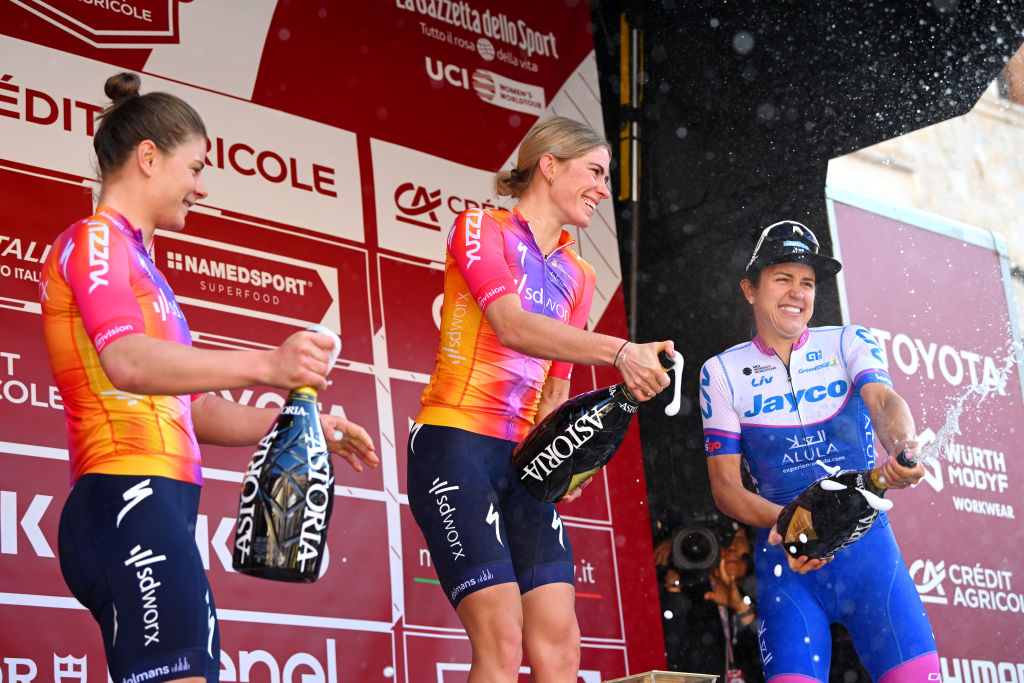UCI ‘examining’ Strade Bianche podium rider’s use of blood monitor
Kristen Faulkner spotted using Supersapiens-style disc on her arm during the race

The UCI is “examining” whether the third placed rider at last weekend’s Strade Bianche, Kristen Faulkner, broke UCI rule by wearing a blood glucose monitor.
Faulkner was pictured wearing the round disc, though to be a blood glucose monitor, on her left arm during the race in which she was the last rider out front ahead of the chasing duo of eventual winner Demi Vollering and her SD Worx team-mate Lotte Kopecky until the dying moments of the race.
The American was also seen with the device in place under her sleeve on the podium.
However, UCI has since issued a reminder that article 1.3.006 of it’s regulation “devices which capture other physiological data, including any metabolic values such as but not limited to glucose or lactate are not authorised in competition”.
A spokesperson for the UCI added: “The UCI has been made aware that Kristen Faulkner (Team Jayco Alula) appears to have been wearing a continuous blood glucose monitor during the Italian UCI Women’s WorldTour event Strade Bianche on 4 March.
“The UCI is currently examining the case and considering applicable procedures and potential consequences.”
A spokesperson for Jayco-AlUla said the team were waiting the outcome of the UCI investigations and would only make a statement after it had concluded.
Get The Leadout Newsletter
The latest race content, interviews, features, reviews and expert buying guides, direct to your inbox!

The device is thought to be one similar to that made by tech company Supersapiens, which markets them as a training aid to gain more data on how your body responds to physical exertion.
That company was founded by type 1 diabetic and founder of diabetic racing team Novo Nordisk Phil Southerland.
The devices have been used by riders at Jumbo-Visma and by marathon world record holder Eliud Kipchoge in the past.
On Saturday Faulkner broke away from the peloton with 40km to go, a typical move for the gutsy daring American rider and one which has given her success in races in the past.
She caught Jumbo-Visma’s Karlijn Swinkels and the pair worked together out front for a time but eventually Swinkels was distanced by the 28-year-old.
Faulkner then used her time trialling skills to try and keep the concerted chase by the SD Worx pair at bay and almost held out. They came round her on the final climb into Sienna, when the best of the American’s legs had clearly already been spent.
A podium seemed a fitting reward for such a performance, now she will have a wait to see if she’ll be allowed to keep it.

Thank you for reading 20 articles this month* Join now for unlimited access
Enjoy your first month for just £1 / $1 / €1
*Read 5 free articles per month without a subscription

Join now for unlimited access
Try first month for just £1 / $1 / €1
Having trained as a journalist at Cardiff University I spent eight years working as a business journalist covering everything from social care, to construction to the legal profession and riding my bike at the weekends and evenings. When a friend told me Cycling Weekly was looking for a news editor, I didn't give myself much chance of landing the role, but I did and joined the publication in 2016. Since then I've covered Tours de France, World Championships, hour records, spring classics and races in the Middle East. On top of that, since becoming features editor in 2017 I've also been lucky enough to get myself sent to ride my bike for magazine pieces in Portugal and across the UK. They've all been fun but I have an enduring passion for covering the national track championships. It might not be the most glamorous but it's got a real community feeling to it.
-
 'It took everything' - Puck Pieterse outclimbs Demi Vollering to win La Flèche Wallonne
'It took everything' - Puck Pieterse outclimbs Demi Vollering to win La Flèche WallonneDutch 22-year-old shows Classics pedigree with first one-day victory
By Tom Davidson
-
 Tadej Pogačar flies to dominant victory at La Flèche Wallonne
Tadej Pogačar flies to dominant victory at La Flèche WallonneSlovenian takes second win at Belgian classic ahead of Kévin Vauquelin and Tom Pidcock
By Tom Thewlis